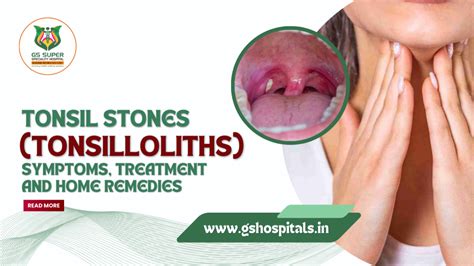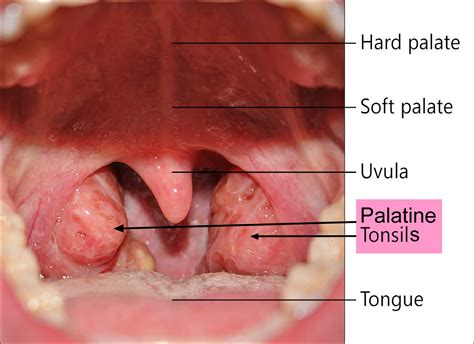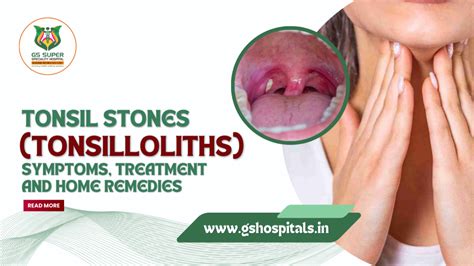Intro
Tonsilloliths treatment options include removal, antibiotics, and home remedies, alleviating symptoms of bad breath, sore throat, and tonsil stones, promoting oral health and preventing recurrence with effective tonsil stone removal techniques and preventive measures.
Tonsilloliths, also known as tonsil stones, are small, hard deposits that form on the surface of the tonsils. These deposits are usually made up of debris, such as dead cells, mucous, and bacteria, that accumulate in the crevices of the tonsils. Tonsilloliths can cause a range of symptoms, including bad breath, sore throats, and difficulty swallowing. In some cases, tonsilloliths can also lead to more serious complications, such as tonsillitis and peritonsillar abscess. As a result, it is essential to explore the various tonsilloliths treatment options available to manage and prevent these issues.
The formation of tonsilloliths is often associated with poor oral hygiene, large tonsils, and a diet high in dairy products and sugar. Additionally, people with gastroesophageal reflux disease (GERD) and sinus infections are more likely to develop tonsilloliths. To prevent the formation of tonsilloliths, it is crucial to practice good oral hygiene, including regular brushing and flossing, and to avoid foods that can trigger their development. However, for those who already have tonsilloliths, there are several treatment options available to help manage and eliminate them.
Tonsilloliths can be diagnosed through a physical examination, where a doctor or dentist will visually inspect the tonsils for any signs of deposits. In some cases, a CT scan or X-ray may be necessary to confirm the diagnosis. Once diagnosed, there are several tonsilloliths treatment options available, ranging from home remedies to surgical procedures. The choice of treatment will depend on the severity of the symptoms, the size and location of the tonsilloliths, and the overall health of the individual.
Tonsilloliths Treatment Options Overview

There are several tonsilloliths treatment options available, including home remedies, medications, and surgical procedures. Home remedies, such as gargling with salt water and using a waterpik, can help to loosen and remove tonsilloliths. Medications, such as antibiotics and pain relievers, can help to manage symptoms and prevent complications. Surgical procedures, such as tonsillectomy and laser tonsil cryptolysis, can help to remove the tonsilloliths and prevent future formation.
Home Remedies for Tonsilloliths
Home remedies are often the first line of treatment for tonsilloliths. These remedies can help to loosen and remove the deposits, reducing the severity of symptoms. Some common home remedies for tonsilloliths include: * Gargling with salt water to help reduce inflammation and kill bacteria * Using a waterpik to dislodge the deposits * Drinking plenty of water to stay hydrated and thin out mucus * Avoiding foods that can trigger the formation of tonsilloliths, such as dairy products and sugar * Practicing good oral hygiene, including regular brushing and flossingMedications for Tonsilloliths

In some cases, medications may be necessary to manage symptoms and prevent complications. Antibiotics, such as penicillin and amoxicillin, can help to treat bacterial infections that may be contributing to the formation of tonsilloliths. Pain relievers, such as acetaminophen and ibuprofen, can help to manage pain and discomfort. Additionally, antacids and acid reducers can help to manage symptoms of GERD, which can contribute to the formation of tonsilloliths.
Surgical Procedures for Tonsilloliths
Surgical procedures may be necessary for large or persistent tonsilloliths. Tonsillectomy, which involves the removal of the tonsils, is a common surgical procedure for tonsilloliths. Laser tonsil cryptolysis, which involves the use of a laser to remove the deposits, is another option. These procedures can help to prevent future formation of tonsilloliths and manage symptoms.Tonsillectomy for Tonsilloliths

Tonsillectomy is a surgical procedure that involves the removal of the tonsils. This procedure can help to prevent future formation of tonsilloliths and manage symptoms. Tonsillectomy is usually performed under general anesthesia and requires several days of recovery. During the procedure, the surgeon will remove the tonsils and any surrounding tissue that may be affected by the deposits.
Laser Tonsil Cryptolysis for Tonsilloliths
Laser tonsil cryptolysis is a minimally invasive procedure that involves the use of a laser to remove the deposits. This procedure can help to prevent future formation of tonsilloliths and manage symptoms. Laser tonsil cryptolysis is usually performed under local anesthesia and requires minimal recovery time. During the procedure, the surgeon will use a laser to remove the deposits and any surrounding tissue that may be affected.Prevention of Tonsilloliths

Prevention is key to managing tonsilloliths. Practicing good oral hygiene, including regular brushing and flossing, can help to prevent the formation of tonsilloliths. Avoiding foods that can trigger the formation of tonsilloliths, such as dairy products and sugar, can also help. Additionally, staying hydrated and managing symptoms of GERD can help to prevent the formation of tonsilloliths.
Dietary Changes for Tonsilloliths Prevention
Dietary changes can help to prevent the formation of tonsilloliths. Avoiding foods that can trigger the formation of tonsilloliths, such as dairy products and sugar, can help. Additionally, eating a balanced diet that includes plenty of fruits and vegetables can help to keep the tonsils healthy. Staying hydrated by drinking plenty of water can also help to thin out mucus and prevent the formation of tonsilloliths.Conclusion and Next Steps

In conclusion, tonsilloliths are a common condition that can cause a range of symptoms, including bad breath, sore throats, and difficulty swallowing. There are several tonsilloliths treatment options available, ranging from home remedies to surgical procedures. By practicing good oral hygiene, avoiding foods that can trigger the formation of tonsilloliths, and managing symptoms of GERD, individuals can help to prevent the formation of tonsilloliths. If symptoms persist, it is essential to consult with a doctor or dentist to determine the best course of treatment.
We invite you to share your thoughts and experiences with tonsilloliths in the comments below. Have you tried any of the tonsilloliths treatment options mentioned in this article? What were your results? Share your story to help others who may be struggling with this condition.
What are tonsilloliths?
+Tonsilloliths, also known as tonsil stones, are small, hard deposits that form on the surface of the tonsils.
What causes tonsilloliths?
+Tonsilloliths are caused by the accumulation of debris, such as dead cells, mucous, and bacteria, in the crevices of the tonsils.
How are tonsilloliths treated?
+Tonsilloliths can be treated with home remedies, medications, and surgical procedures, depending on the severity of symptoms and the size and location of the deposits.
Can tonsilloliths be prevented?
+Yes, tonsilloliths can be prevented by practicing good oral hygiene, avoiding foods that can trigger their formation, and managing symptoms of GERD.
What are the symptoms of tonsilloliths?
+The symptoms of tonsilloliths include bad breath, sore throats, difficulty swallowing, and white or yellow deposits on the tonsils.
